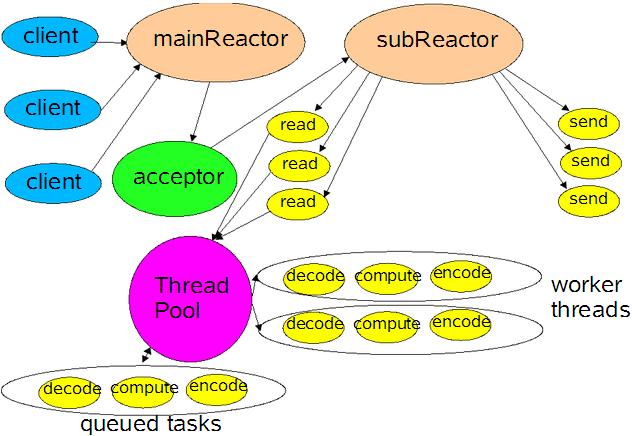Reactor 模式在Netty中的应用
典型的Rector模式

mainReactor
服务端创建成功后,会监听Accept操作,其中ServerSocketchannel中的PipeLine中现在包含3个handler

服务端监听到连接事件后,会创建代表客户端的socketChannel,并向workgroup注册channel,监听后续该channel读写事件。一言以蔽之,bossGroup只负责接收连接请求,并创建socketChannel,分发到workgroup中执行耗时的读写操作。
接收连接请求
if ((readyOps & (SelectionKey.OP_READ | SelectionKey.OP_ACCEPT)) != 0 || readyOps == 0) {
unsafe.read();
}
try {
do {
int localRead = doReadMessages(readBuf);
if (localRead == 0) {
break;
}
if (localRead < 0) {
closed = true;
break;
}
allocHandle.incMessagesRead(localRead);
} while (allocHandle.continueReading());
注意ServerSocketchannel的allocHandle默认最大为1。
@Override
protected int doReadMessages(List<Object> buf) throws Exception {
SocketChannel ch = SocketUtils.accept(javaChannel());
try {
if (ch != null) {
buf.add(new NioSocketChannel(this, ch));
return 1;
}
} catch (Throwable t) {
try {
ch.close();
} catch (Throwable t2) {
}
}
return 0;
}
在接收到连接请求后,会触发PipeLine的firChannelRead事件。pipline中包含ServerBootstrap,read方法如下:
public void channelRead(ChannelHandlerContext ctx, Object msg) {
final Channel child = (Channel) msg;
child.pipeline().addLast(childHandler);
setChannelOptions(child, childOptions, logger);
for (Entry<AttributeKey<?>, Object> e: childAttrs) {
child.attr((AttributeKey<Object>) e.getKey()).set(e.getValue());
}
try {
childGroup.register(child).addListener(new ChannelFutureListener() {
@Override
public void operationComplete(ChannelFuture future) throws Exception {
if (!future.isSuccess()) {
forceClose(child, future.cause());
}
}
});
} catch (Throwable t) {
forceClose(child, t);
}
}
至此,将NioSocketChannel注册到workgroup中执行。